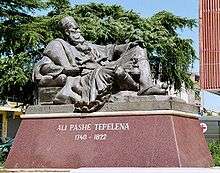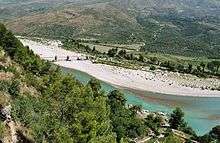Tepelenë
| Tepelenë | ||
|---|---|---|
| Municipality | ||
| ||
 Tepelenë | ||
| Coordinates: 40°18′N 20°1′E / 40.300°N 20.017°ECoordinates: 40°18′N 20°1′E / 40.300°N 20.017°E | ||
| Country |
| |
| County | Gjirokastër | |
| Government | ||
| • Mayor | Tërmet Peçi (SP) | |
| Area | ||
| • Municipality | 431.24 km2 (166.50 sq mi) | |
| Population (2011) | ||
| • Municipality | 8,949 | |
| • Municipality density | 21/km2 (54/sq mi) | |
| • Administrative Unit | 4,342 | |
| Time zone | CET (UTC+1) | |
| • Summer (DST) | CEST (UTC+2) | |
| Postal Code | 6301 | |
| Area Code | (0)814 | |
| Vehicle registration | AL | |
Tepelenë (definite Albanian form: Tepelena) is a town and a municipality in Gjirokastër County, in the south of Albania. The town is located on the left bank of the Vjosa River,[1] about three kilometres downstream from its union with the Drino.
Until the abolition of Districts in 2000, Tepelenë was the seat of the Tepelenë District. Its location is strategically important and there is a ruined citadel occupying a point 300 metres above the river. Ali Pasha of Tepelenë was born at the nearby village of Beçisht. In 1847, the British writer Edward Lear visited the town and noted the devastated buildings.
History

At the nearby Vjosa (Greek:Aoos) Narrows ("Aoi Stena"), a Macedonian army barred the way to Epirus and, in 198 BC, a decisive battle, the Battle of the Aous, took place between a Roman army commanded by Consul Titus Quinctius Flamininus and the Macedonians commanded by Philip V. After an attempt of a truce and an inconclusive battle, a sheperd led the Roman army to a point where the Macedonians could be attacked and the Romans won the battle.
The Byzantines built a defensive tower which was successively developed during the Ottoman Empire epoch in the 15th century and by Ali Pasha in the early 19th century.
The Young Turk revolutionaries met in Tepelenë in February 1909, in an attempt to persuade Albanian nationalists to join them.[2]
In 1920, an earthquake severely damaged the town which was completely rebuilt afterwards. Local tradition says that if Tepelenë exceeds 100 buildings it will be destroyed. In the same year, 400 Italian soldiers surrendered to the Albanians during the Battle of Vlora.
On 7 April 1939, Italian forces landed in Albania and took control of the country and Tepelenë in the beginning of World War II.[3] After the Italian offensive on Greece in October 1940 failed, the Albanian troops in Tepelenë under the command of Colonel Prenk Pervizi deserted the Italian army. The colonel protested by telling the Italian command that the Albanians were not cannon fodder.[4] As a consequence, Colonel Pervizi as well as other officers and Albanian troops were transferred into the mountains of northern Albania and isolated there. This "betrayal" by the Albanian troops initiated a great defeat of the Italians against the Greek army. This was the first revolt against the Italian occupation.
Greek forces counter-attacked and advanced towards Tepelenë in a general offensive on Vlorë. Despite several attacks and assistance for the Greeks by the British Royal Air Force, the Italians managed to hold the town and in late April 1941, following the German invasion of Yugoslavia, the Greek army was forced to withdraw.[5]
Later, the post-war Communist regime converted the local Italian army camp into a forced labour camp. Influential Albanian families involved in the previous governments were detained here. Some died and their graves were unmarked [6] by plowing the land and sowing rye where in the burial spot. The camp was closed in 1954. At one point a cholera epidemic killed many inmates.[7]
In the 1997 unrest in Albania, Tepelenë became a focal point for the uprising against Sali Berisha's government. A people's committee took charge of the town in March 1997 and released opposition politician Fatos Nano from the local prison. The movement spread immediately to Gjirokastër where weapons were distributed from Tepelenë.
Geography
Tepelenë is located on the left shore of the Vjosa River on a plateau above the river. The river applies here, after the river has broken through a few kilometres in the Këlcyrë Gorge a mountain chain, to the North. In addition the Drino flows at this point. North of Tepelenë, the Bënça river coming from the south-west from the Kurvelesh flows into the Vjosa.
Tepelenë was formed at the 2015 local government reform by the merger of the former municipalities Kurvelesh, Lopës, Qendër Tepelenë and Tepelenë, that became municipal units. The seat of the municipality is the town Tepelenë.[8]
Demographics
The total population of the city is 8,949 (2011 census), in a total area of 431.24 km2.[9] The population of the former municipality at the 2011 census was 4,342.[10]
Economy

The local mineral water plant is an important and successful local enterprise.
Transport
Thanks to its location at the confluence of two valleys, Tepelena has always been an important traffic hub in southern Albania. The National Road 4 (SH4), from Fier to Gjirokastër, continues through Tepelenë.
Culture

Sports
The local football club is SK Tepelena.
Notable people
- Ali Pasha
- Foto Strakosha, soccer player Albania capped
- Muhedin Targaj, soccer player Albania capped
- Isuf Kalo, notable physician, personal doctor of Enver Hoxha
- Gramoz Ruçi, head of the Parliamentary Socialist Group
- Valentina Leskaj, former Minister of Work and Social Welfare
- Tafil Buzi, leader of the Albanian Revolts of 1833-39.
See also
References
- ↑ "Tepelene". travelsradiate: travelsradiate.com. Retrieved Jan 24, 2011.
- ↑ Pearson, Owen (2004). Albania in the Twentieth Century, A History: Volume I: Albania and King Zog, 1908-39. I. B. Tauris. pp. 5–8. ISBN 1845110137. Retrieved 31 July 2012.
- ↑ Piero Crociani, "Gli albanesi nelle forze armate italiane, Roma 2001".
- ↑ Pjeter Hidri, "The General Prenk Pervizi, Toena, Tirana, 2002.
- ↑ Pearson, Owen (2006). Albania in Occupation and War: From Fascism to Communism 1940-1945. pp. 102–143. ISBN 1-84511-104-4. Retrieved 19 March 2010.
- ↑ Lek Pervizi, "Ankimi i Zanave, (poetry), Arberia, Tirana, 2002.
- ↑ Gjuliana Malaj, "Une Beba, qe u futa ne camp kater muajshe e dola 42 vjeçe, Panorama, Tirana, 25 october 2012.
- ↑ Law nr. 115/2014
- ↑ Interactive map administrative territorial reform
- ↑ 2011 census results
- Blue Guide to Albania and Kosovo, James Pettifer, A&C Black, London, 2001
- Albania in the Twentieth Century, A History: Volume I: Albania and King Zog, 1908-39 , Owen Pearson,I. B. Tauris,2004







